Life on the NFL’s Chain Gangs
As Washington and Dallas slogged through the final minutes of a rain-soaked third quarter at fanless FedEx Field, there was little drama to be found. Neither team had scored since halftime, Washington was winning by 19, and the Cowboys, down to their third-string quarterback, were punting from their own 31 to end a fifth straight empty possession.
Then calamity struck.
“Oh, f---,” Mark Ingrao said, “We have a problem.”
It happened along the Washington sideline, around the start of the television timeout. Ingrao and crewmate Jennifer Hein were busy dodging the usual change-of-possession foot traffic, heading to set up for the next drive. Neither of them saw the culprit, but a player’s cleat had stomped on the chain near the base of Hein’s measuring stick and snapped it. Now, they were hit with the sobering realization that Ingrao was dragging 10 yards of limp steel behind him.
“S---,” said Hein. “What are we going to do?”
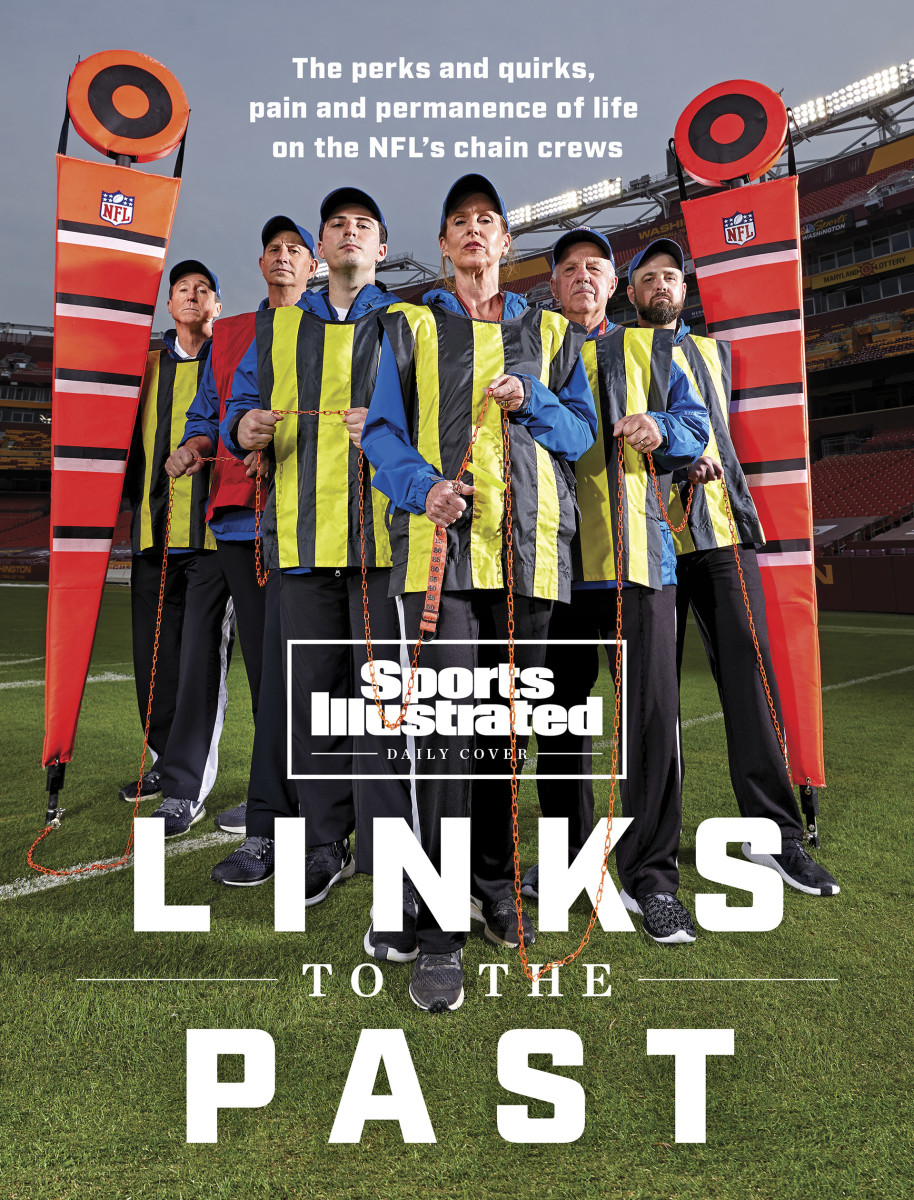
Like so many chain crew members clad in NFL-issued pinnies, blue ball caps and referee knickers (and now mandatory medical face masks), Hein and Ingrao have no shortage of tales from the painted white lines of duty. Five years ago Ingrao received seven stitches and found himself in concussion protocol after an oblivious Buccaneer scrambling onto the field whacked him upside the head with a helmet, briefly knocking him out. Hein earned fleeting Football Twitter fame in 2014 when cameras caught her mouthing another four-letter expletive after an officiating mixup caused the first-down markers to move too soon. But the pair had never, in 60 combined seasons on Washington’s chain crew, encountered a broken chain.
Now it was a two-minute drill in the most literal sense, the ad break ticking away and no chance to kill the clock. Ingrao first checked to see if the link was fixable—it very much was not. So he did the only thing he could: He ran.
Dumping his stick on the grass, the 62-year-old sprinted through the bench area. He cut through coaches and juked around players until he reached the spot near midfield where the crew kept a backup set of down markers it had never needed, until now.
Spare equipment on his shoulders, Ingrao huffed back to Hein at the Washington 25, the new line of scrimmage. There they set about untangling the chain, stretching out the sticks and, ultimately, triumphantly, scrambling into their positions, 10 yards apart, just as play resumed.
Aside from a bemused on-field official who later complimented Hein and Ingrao for making it back for the snap—Great job, guys! I’ve never seen anybody do that in two minutes!—nobody within eyeshot appeared to catch their heroics. Not that they minded. “For us chain crew geeks,” Hein says, “it was a cool moment.”
Such is the life of football’s ficus plants, those forgettable ornaments of sideline feng shui, forever lurking in the corner of your screen whenever the camera cuts to a coach. (See also: ballboys, photographers, backup quarterbacks.) “Half the time, people [on the field] are so into the game, they don’t even know we’re there,” Hein says. “Unless they trip on the chain.”
Together, though, Hein and her ilk are far more famous than the rest of the supporting cast that keeps the NFL machine humming. What fan wouldn’t recognize the chain gang? They are the cartoon figures hup-hup-huping on stadium JumboTrons after big gains by the home team, encouraged by a crowd chanting, “MOVE! THOSE! CHAINS!” They star in a Progressive ad campaign about two crewmates who never drop the sticks and therefore never leave each other’s side, including in the bathroom. They are those average Joes and Janes who get to jog onto the field and participate in the timeless custom of measuring a first down with two tall poles and 10 yards of metal. “We’re part of the NFL tradition,” Ingrao says.
Above all, to claim a precious place on one of the league’s 32 chain crews is to exist in a singular football family. The pay, predictably, is low. The fear of messing up on live TV is constant. The threats to their livelihood—whether posed by tackles spilling past the sideline or new technology—are all too real. But their shared experiences are singular.
“Not everybody can do it,” says Jim Heutter, who spent four decades on the Bills’ crew and now operates the play clock upstairs. “Some people say to me, ‘That looks like fun, I’d love to be down there.’ Well, it is, but there’s a lot of pressure. I wouldn’t call it fun. I would call it more of a … unique experience.”
* * *
On March 31, 1906, at a posh New York City hotel with gryphon statues flanking the lobby’s marble staircase, a relatively nascent group of pigskin power brokers known as the American Intercollegiate Football Rules Committee met. Under the leadership of Harvard coach William T. Reid and Yale coach Walter Camp, the group made what one national newspaper described as “numerous and radical changes” to the rules of the sport.
Many of these new guidelines were geared toward curbing on-field violence, an issue that had resulted in dozens of deaths since the turn of the century. Thus, the unnecessary roughness penalty, the restricted forward pass and the fair catch. Also notable: Teams now needed to gain 10 yards for a first down, up from five.
The job of marking this progress fell to the linesman, one of then four on-field officials (along with a referee, umpire and field judge). To assist in this task the linesman would be “provided with two assistants … who shall use in measuring distance two light poles or rods about 6 feet in length, connected at their lower end by a stout cord or chain 10 yards in length,” according to Spalding’s early 20th-century Official Foot Ball Guide.
Today’s measuring sticks are taller (eight feet or so), protected by padded banners, and topped with fluorescent bull’s-eyes that wouldn’t look out of place on a carnival dunk tank. The chain itself is now finished in smooth orange coating. “Years ago, it was just a chain,” Ingrao says. “You could get your hand cut pretty easily.” A dreidel-looking wooden block, speared on a metal skewer with a number written on each face, once indicated the down, but then television ushered in the flip-over numbers that later begat the Dial-A-Down box.
Otherwise, the system has remained the same for more than a century. “It’s an inexpensive way for players to know where things are,” says David Haring, a Jets crew member since 1985. “People criticize us, like, ‘How can they have these old guys holding chains for a billion-dollar corporation?’ Well, nice window dressing. Plus we don’t make that much money.”
At $150 per game Haring and the Jets are on the high end of the spectrum, with most crews earning $75 to $100 and asked to arrive at least 90 minutes before kickoff to dress, check the chain for kinks, ensure the backup sticks are in place and meet with the down judge (formerly head linesman). But most everyone has a regular day job: Ingrao is a trade association executive. Hein, 47, owns an IT firm. Teachers and firemen populate the Arizona Cardinals gang. Plus the perks compensate plenty—namely parking, pregame meals and more league-branded gear than a closet can hold. “How many NFL blue raincoats do you really need?” Haring says.
As the Washington chain crew chief, Hein even gets compensated with a pair of season tickets. Her title here is an unofficial one, at least as far as the commissioner’s office is concerned, but it’s important nonetheless; the NFL doesn’t oversee chain crews, delegating responsibility to individual teams who, in turn, tend to leave it to the crews to hire who they want, hand out assignments how they choose and form their own internal chain of command.
Most crews had eight or more members before the 2020 season, not including at least one alternate on hand for emergencies. There was the “box man” and the “auxiliary box man,” dressed in red smocks and stationed on opposite sidelines to display the down. (Terms are taken from a two-page document provided by an NFL spokesperson outlining the responsibilities of each crew member.) Two “chain men” carried the sticks on the official side, while the “line-to-gain pole” showed the first-down spot on the auxiliary side. The “clip man” oversees a marker that attaches to the chain at the nearest yard line that’s a multiple of five—that way, if the crew takes the field for a measurement, or bails out to avoid getting hit, the clip allows them to line back up properly. The “data person” tracks the down, distance and ball spot as a backup for the officials and the scoreboard operator. The “penalty card person” recorded the specifics of every flag.
But when the NFL made broader cuts to sideline personnel because of the COVID-19 pandemic, these crews took a hit. Gone, for example, is Hein’s old role on the penalty card. (A press box official does that now.) Now only five workers remain: two chain men, one down-box operator on each sideline and one holding a yard-to-gain pole on the auxiliary sideline.
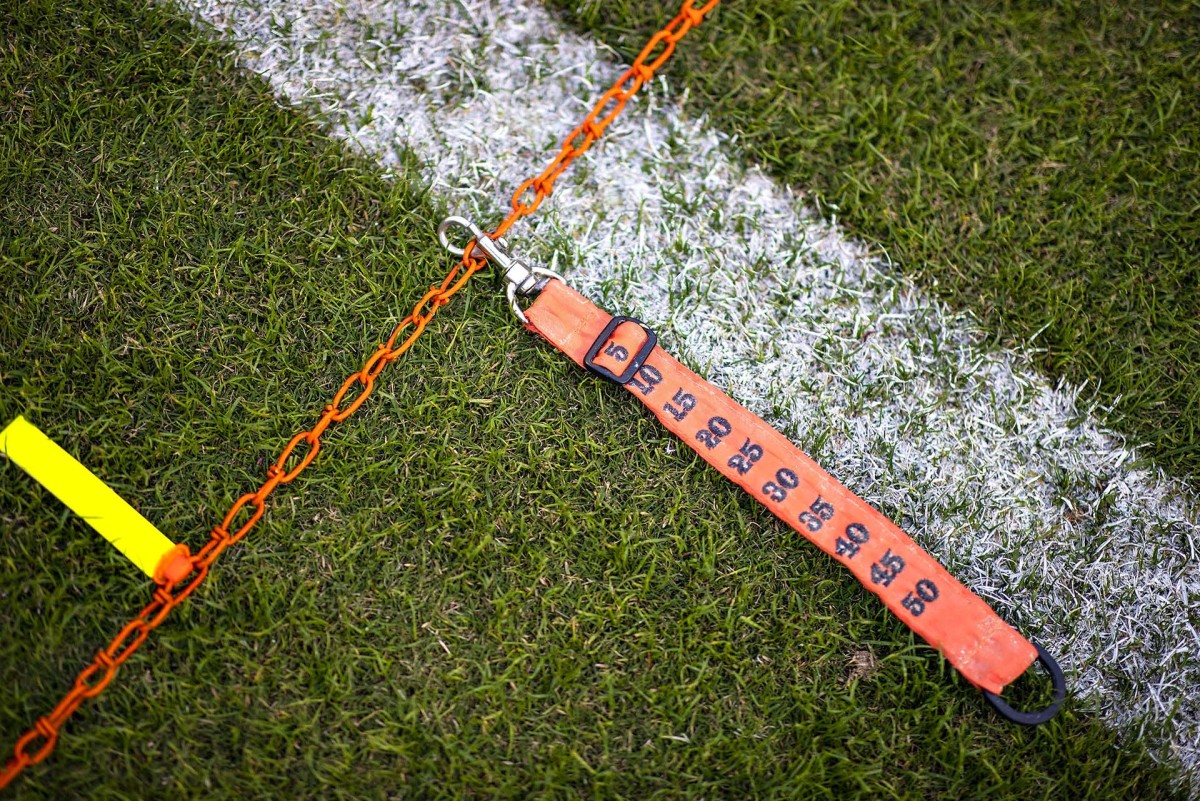
The asks aren’t exactly strenuous. “Eighty percent of the job is showing up,” Haring says. But there are tricks of the trade. Al Nastasi III and the crew in New Orleans put pieces of tape on the Superdome turf whenever the ball moves behind the first-down line of scrimmage, just in case the down box man loses his spot and the zebras forget. “We have a lot of backup systems,” Nastasi, 46, says. “We hopefully don’t make too many mistakes.”
Unless that happens, anonymity is the norm. In 1988, having spent the past 12 years as the box man on the Giants’ chain crew, Jim Quirk attended the league’s annual refereeing clinic, at the Dallas-Fort Worth Airport Marriott, as a rookie official. “All these guys looked at me strangely, asking, ‘Where do I know you from?’” says Quirk, who went on to become executive director of the NFL Referees Association and a well-known umpire, if only for his penchant for diving into player scrums. “They didn’t remember my name, but they recognized my face.”
But there are exceptions. A decade ago, longtime Ravens crewmate Bob Wobbeking summoned the courage to pipe up and correct a referee who was wrongly marking off penalty yardage from the back end of the sticks, instead of from the down box. “He appreciated it,” Wobbeking, 72, says. “He came into our locker room afterward and gave me a game ball.”
* * *
Like small-town diners, or the mob, NFL chain gangs are family businesses.
In Washington, Ingrao’s father and Hein’s grandfather made up half the crew’s original “four families” when the team started at Griffith Stadium during the Great Depression. The current Washington crew has a father-son team, Joe and Frank Beddick, as do the Saints and the Cardinals, among others. Lions crew chief Chuck Darany shares a sideline with daughter Olivia in Detroit. Until he passed away in November, Tom Quinn led the Giants crew for nearly four decades, just like his father, Ed. He is succeeded on the current gang by three cousins.
Haring similarly followed in his dad’s footsteps, starting as an alternate after college before replacing Henry Haring on the Jets crew in 1984—after the final game at Shea Stadium, Dad moved upstairs to work the play clock. In ’98, when his father passed away on a Saturday, David honored this legacy by showing up at the Meadowlands that Sunday.
Even for those who aren’t related by blood, the chains are enough to make them kin. Which means they stick up for one another, like when Ingrao and Hein’s predecessor, George Richardson, prevailed in a fight against then-Washington owner George Preston Marshall to revoke the firing of a fellow crew member who had booed Marshall at a local football banquet. They take care of one another, whether it’s Ronnie Kornick baking a king cake for every New Orleans home game, Arizona’s Jim Foster serving up his secret salsa recipe around the holidays or Wobbeking meeting the Ravens gang for their end-of-season crab feasts.
They also watch out for each other from afar. “When I’m looking at a game on TV, I’m looking at the chain gang guys,” Kornick says, and he is far from the only one. "What tickles me: I’ve seen some of the chain crews working without hats, working in shorts,” says Larry Yocum, who like Wobbeking started with the Ravens for the team’s inaugural season, in 1996. “My chain crew is completely professional. They dress like it, they wear the right uniform." With everyone being local, friendships spanning multiple crews aren’t common … although Hein and others report making connections through a private Facebook group of NFL-only members called Back on the Chain Gang.

When it comes to the hiring process, the NFL does basic screening, including background checks and a yearly signed pledge that crewmates won’t bet on games or bring their cell phones onto the field. Nepotism doesn’t reign on every sideline—“We’ve never had anybody’s son,” says Yocum—but positions are predominantly filled by word of mouth, and references go a long way. Like when Hein took over for her father in ’98. “He’d been doing this for almost 30 years, and he didn’t seem to be enjoying it as much anymore” she says. “So he was like, ‘I’m done, you’ve got to do this.’”
Indeed, vacancies on the chain crews are about as frequent as those on the Supreme Court. In his old role as the NFL’s vice president of officiating, Mike Pereira would receive some 50 yearly emails from fans inquiring about getting on their local chain crews. “And I’m like, ‘I’d like to be optimistic, but forget about it. Most of these positions have been handed down from one generation to another in the same family.” Or, as Kornick puts it, “Somebody’s gotta die, or get an injury where they can’t see or walk anymore for somebody to move on.”
Which brings us to perhaps the most important skill needed to survive on the crew. “When the runner comes your way,” says Quirk, “get the hell out of the way.”
* * *
Overhearing the television, Nastasi felt his stomach sink. It was Oct. 24, 2010. The Saints were hosting the Browns, and the broadcast had just announced that an official had gone down. “I just had this ominous feeling,” Nastasi recalls. “My wife said, ‘That can’t be your dad. He’s not part of the officiating crew.’ I said, ‘No, we are part of the officiating crew.’”
Before the broadcast could break the news, an NFL representative called Nastasi’s mother at home, confirming his fear. Midway through the third quarter, racing out of bounds along the sideline in punt coverage, Saints gunner Courtney Roby had slammed into chain man Al Nastasi Jr., sending the area high school track coach to the ICU with a subdural brain bleed.
Nastasi Jr. spent the next two weeks at the hospital, “in and out of it,” he says. (Miraculously he appeared to suffer no long-term effects, even returning behind the sticks later that season: “It wasn’t even a second thought. I was going to persevere.”) Roby was among his earliest visitors in the ICU, and the Saints later gave him an autographed football. But there were no hard feelings to smooth over. “I took my eyes off the gunner,” Nastasi Jr. says. “It was my mistake.”
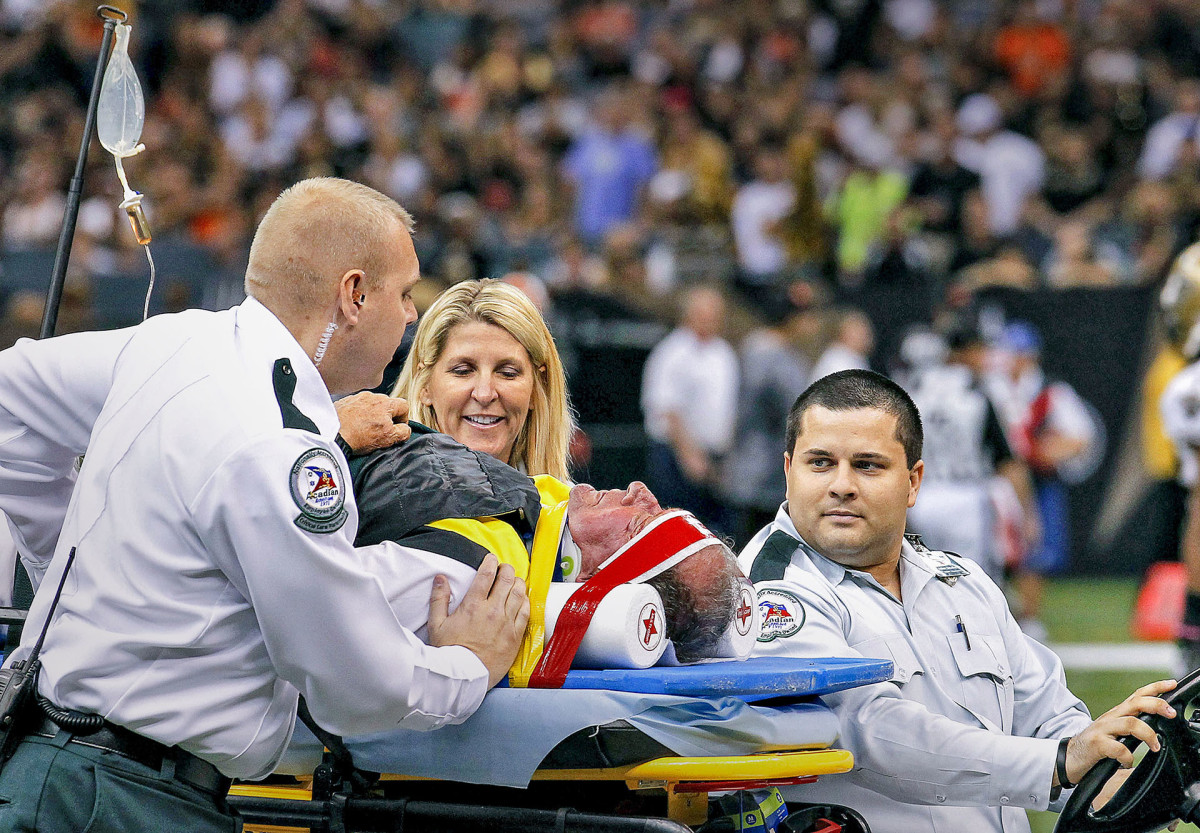
Of all the possible sins to commit while working a job that alternates between standing still and walking short distances, the worst boil down to not paying attention. Mostly these result in gaffes that bring shame upon the crew. “If you have the wrong number on the down marker, that’s embarrassing,” Kornick says. But there are more serious risks too. That’s why Yocum and the Ravens crew keep each other on high alert by hollering “Punt time!” on fourth-and-long, lest anyone get trampled by a gunner, the kicking team’s outermost players who often get pushed across the sideline while sprinting downfield. “You’ve got to watch out,” Yocum says.
In addition to watching they also get the pleasure of listening—to the roars of the crowd, to the hilarious snippets of player trash talk, to the beet-red coaches turning their anger on the ficus plants. (Once, after replying to Andy Reid’s question about whether a first down had been reached with a noncommittal, “I think so,” the then-Eagles boss shot back, “You think so? You should know!”) But most of all, crew members can still feel the pain if they have ever been hit.
In Arizona, Jim Foster took a wayward Troy Aikman pass to the gut, leaving the stadium with a bruise shaped like the nose of a football. After a multiplayer tackle spilled out of bounds and Colts chain man Steve Taylor was tripped up in the fray, he got a call that night from his mother who first asked, “Are you O.K.?” before saying, sweetly, “Son. That was so funny.” Hein narrowly avoided disaster when star safety Sean Taylor, barreling toward the sidelines to make a tackle, eased up at the last moment, scooped Hein in his arms and carried her to safety. “I was shaking for the next 10 minutes,” Hein says.
Some go down in a heap, others go down in infamy. Like Tampa Bay’s Bobby Lastra, sued by the late defensive end Bubba Smith for negligence in a 1972 preseason game after a collision involving the sticks mangled Smith’s knee. (The jury deliberated for two hours and awarded Smith nothing.)
But such a case is rare. Aside from the occasional small-town newspaper profile, the vast majority of crew members—happily—never earn any notoriety. But that doesn’t mean they don’t also enjoy those few seconds in the spotlight whenever they’re needed on the field.
***
You know the scene. Fourth down, football spotted oh-so-close to a first. Players crowd around, each team tomahawking their hands in opposite directions. Out come the chains. Hup-hup-hup. Out stretch the sticks. The officials gather. One kneels and inspects. The cameras zoom in. “That’s definitely your TV time,” Nastasi Jr. says.
It’s the most common question crew members get: What’s it like to go out there? One answer is that it can make them feel self-conscious as all get-up—not the least of which is because of their getup. “Have you seen those outfits?” Kornick says. “How do you look cool in a black and yellow vest?” Another is that it makes everything worthwhile. "You get your little three seconds of fame," Kornick says.
Some crew members say they are taught to back away from the ball after handing off the chains, lest they block the camera. But there are subtle ways to be seen. Before he moved to the booth Huetter would remove his hat and run a hand through his hair as a signal to friends watching the Bills game. David Haring still sometimes gives a low, brief wave.
“That’s our big moment,” he says of the measurements, “which they’ve pretty much eliminated now.”
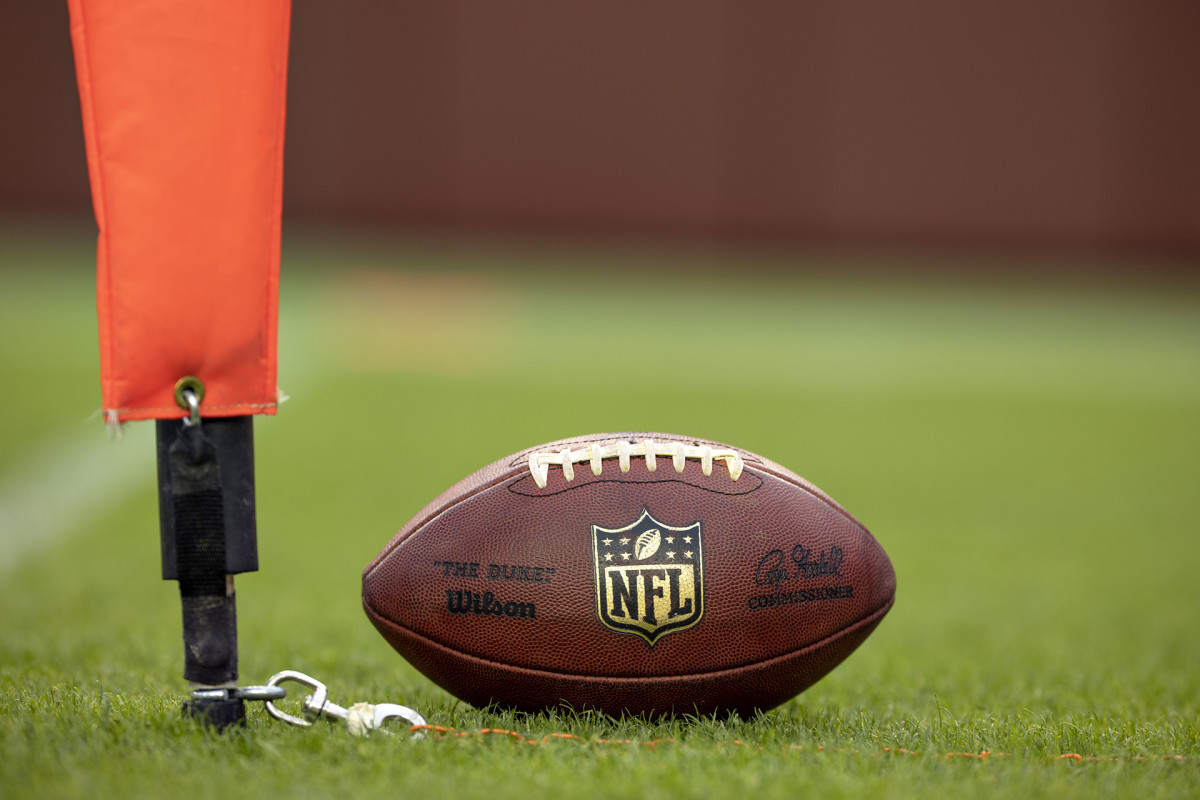
According to the NFL, in-game measurements have hovered steadily between 0.3 and 0.5 per game since 2014, the earliest for which it has such data. Old-timers recall when the rate was much higher, but they also understand the main reasons for cutting back: With officials now seemingly defaulting to exact yard lines when spotting the ball on first down, the yard-to-gain is easier to eyeball. And with the safety net of replay, why slow the game more unless absolutely necessary?
Other than the 2019 elimination of “the X,” a person who did nothing more than stand in the spot where the current drive started, crews hadn’t experienced much drastic change until this pandemic season. Now everything is different. Two days before home games, they get mandatory COVID-19 tests. Upon arrival at the stadium before kickoff, they receive a temperature check and a digital contract tracer to be worn until they leave. Just as jarring, Kornick stopped baking his king cakes.
On the field, with their ranks sliced to five, their margin for error is thinner than ever. For instance, someone on every crew now has to pull double duty by managing the clip, which was previously a job unto itself. “People were a little bit concerned about especially losing the clip guy,” Hein says. “But after the first couple games, everyone was like, ‘You know what, we can do it.’”
All of which makes crew members wonder if more cuts could be coming. “I don’t think it’s going to get down to less than what we have now,” Wobbeking says. “Four would be impossible.” It is something that comes up a lot, whether in locker room chats or Facebook threads: What is the future of a human relic in a sport increasingly infiltrated by technology?
“We always say to ourselves, ‘Will we ever be obsolete?’” Ingrao says.
* * *
Alan Amron had a bright idea.
Granted, this is a common occurrence for the New York City-based inventor, whose 40 U.S. utility patents range from a “dual umbrella” that shields two people from rain to several intricate water guns. But he was feeling especially optimistic about this latest brainchild, born when he attended a Giants game and found himself wondering why the yellow first-down line from television didn’t also appear on the field.
And so, in March 2003, Amron filed a patent application for a “system for operating one or more lasers to project a visible line onto a grass covered surface.” The gadget was described as general-use, suitable for sporting and entertainment venues of all sorts. But an early section of its description makes clear what—or, rather, who—it specifically intended to replace.
“In numerous occasions throughout an average football game, the officials of the game must resort to sideline markers to establish whether the offense has advanced the ball by the required distance,” Amron wrote. “Although the game of football has become a relatively complex sport, involving literally hundreds of millions of invested dollars, this time consuming system has remained relatively the same since the conception of the sport.”
Not that Amron was treading new turf here. As long as humans have measured downs with sticks and chains, others have schemed ways to get them to stop. There have been patents for pulley systems on sideline tracks, aluminum pipes with peep sights and an EDM festival’s worth of laser beams. In the 1950s gym teacher Lou Peresenyi released the Pere-Scope, a four-power rifle scope mounted atop the lead down marker, earning a glowing endorsement from none other than Amos Alonzo Stagg: “It’s the finest thing to happen to football since the forward pass.” Two decades later engineer George Dicker whipped out his unfortunately named Dicker Rod, a single 8-foot pole needing just one crewmate to operate instead of three. Inventor Makes Chain Gang Obsolete, gushed the headline of one Los Angeles Times story.
Dicker’s instrument made slight headway toward this goal, appearing in 174 high school games during the ‘71 season, but never found its way onto an NFL sideline. Amron came closer thanks to an early business partnership that he forged with Pat Summerall, the placekicker turned broadcaster who helped arrange pitch meetings with league power brokers, including Pereira and then league COO Roger Goodell. Amron says plans were even made to test the First Down Laser System, which projects a lime-green strip of light across the field, giving ball-carriers and viewers alike a visual for the first down, in NFL Europe, the league’s overseas offshoot.
Even after NFL Europe folded in ‘07, Amron wasn’t deterred, continuing to make semi-regular overtures through 2013 to the league’s competition committee, which would ultimately decide whether any new technology would replace, or supplement, the chain crew. (Committee head Rich McKay declined an interview request.) Like his predecessors, though, Amron was rebuffed. The reasons included both cold-hard cash—the NFL wanted his lasers tested at a lower level yet none could afford the equipment—and good-ol’ nostalgia. As Amron says of the chains, “We don’t need them, but there are so many people who want to keep them for old time’s sake.”
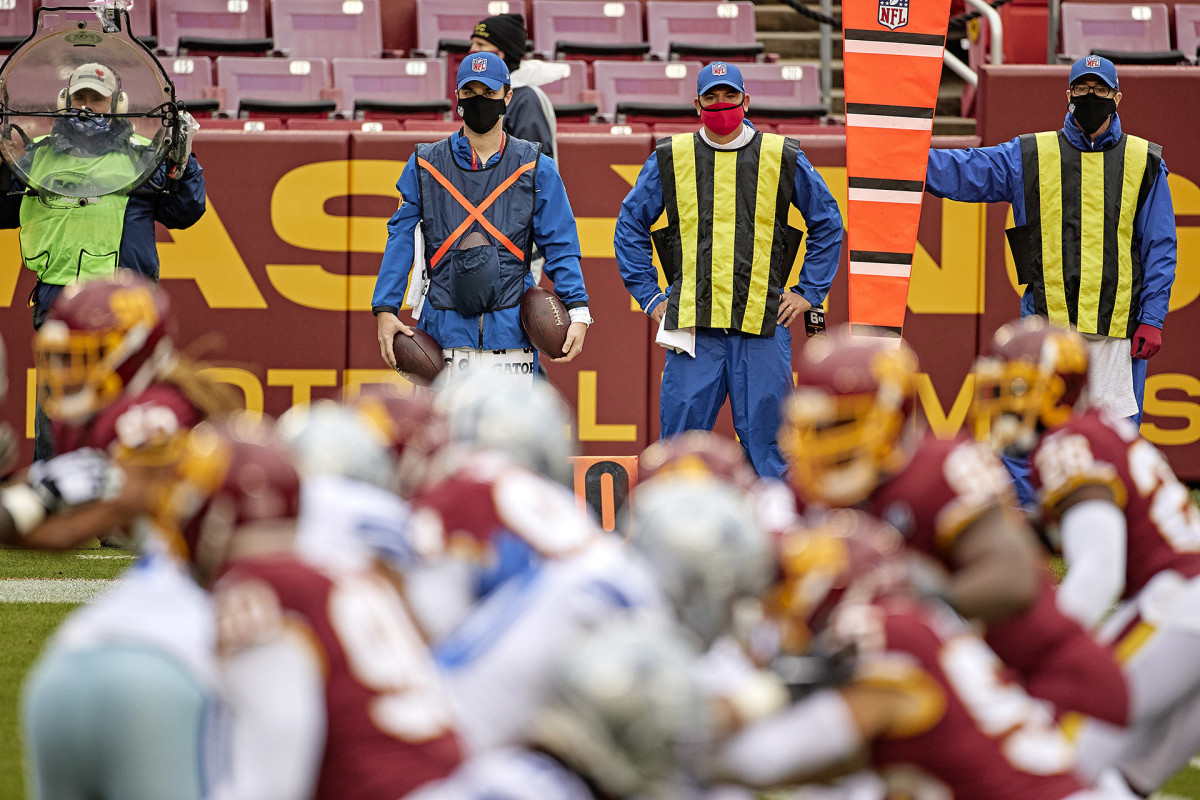
In general, arguments for a new method are based on practical factors, such as speeding up on-field measurements and reducing the safety risk for crew members. The competing camp has sentimentality on its side. “Obviously, it’s not an exact science,” Hein says. “We do the best we can to line up with the ball on the field. But if you get rid of it, you take away that element of suspense. You’d be missing out on the theatrics, the fabric of the whole experience.” After all, ridiculous as it was, who didn’t love seeing NFL ref Gene Steratore produce a folded index card from his pocket to assist with a key first-down ruling during a Cowboys-Raiders game in 2017? “You can present me all the lasers that you want,” Pereira says. “Three old guys running onto the field and stretching a 10-yard chain to see if it’s a first down? That’s beautiful in my mind.”
Until that day of reckoning comes, Hein plans to soak up every bit of her time on the chain gang. Like when one of her sons, Conor, worked his first game upon turning 18 last season, making that four generations of family to do so. Hein had cautioned him against geeking out too much that afternoon, especially because Washington was hosting the Patriots and Conor is a big Bill Belichick fan. “I don’t want to catch you trying to see what plays they’ll run,” she said. But a little sense of starstruck was unavoidable: After jogging onto the field for his first measurement, Conor returned to the sidelines with his eyes wide: “Omigosh,” he said. “That was so cool.”
Ever the protective mother, though, Hein was careful not to throw Conor into the deep end too soon. That’s why she assigned him to carry the back pole of the chain set. Every crew member knows that the front side gets more action. “And I didn’t need him getting hit,” Hein says.
